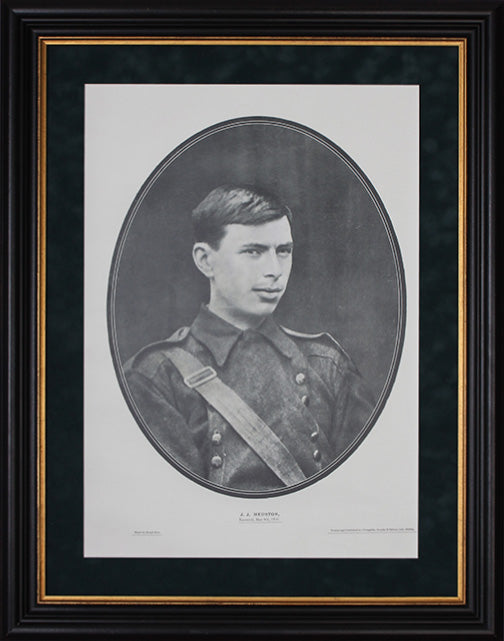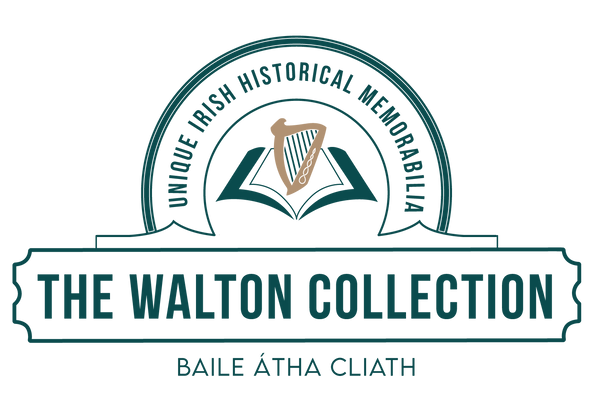The Walton Collection
Sean Heuston - 1916 Poster
Sean Heuston - 1916 Poster
Couldn't load pickup availability
A rare Seán Heuston 1916 commemorative poster.
Seán Heuston was born, John Joseph Heuston, on the 21st of February 1891 and was an Irish republican rebel and member of Fianna Éireann who took part in the Easter Rising of 1916. With about 20 Volunteers, he held the Mendicity Institution on the River Liffey for over two days, though it was originally only intended to be held for just 3–4 hours. He was executed by firing squad on the 8th of May in Kilmainham Gaol.
Heuston was born at Gloucester Street in Dublin on 21 February 1891, the son of a clerk, John Heuston, and Maria McDonald. Educated by the Christian Brothers, he later worked as a railway clerk in Limerick and while there took an active part in Fianna Éireann (a scouting association for young boys), of which he was an officer. Under his guidance the Fianna in Limerick had a course which encompassed not only drilling, but included signalling, scout training and weapons training, in addition to lectures on Irish history and Irish language classes. In 1913 Heuston was transferred to the Dublin Fianna, and was appointed to the Emmet Sluagh. The Fianna was a critical training ground and provided many well-trained and disciplined recruits to the Volunteers. He was Director of Training for Fianna Eireann as well as being Vice-commandant of the Dublin Battalion and Commander of the Volunteers 5th company from August 1915 to Easter 1916.
Heuston was the Officer Commanding the Irish Volunteers assigned to hold the Mendicity Institution (now called Heuston's Fort on the south side of Dublin city). Heuston was to hold this position for three or four hours, to delay the advance of British troops. This delay was necessary to give the headquarters staff time to prepare their defences. Having successfully held the position for the specified period, he was to go on to hold it for over two days, with twenty-six Volunteers. With his position becoming untenable against considerable numbers, and the building almost completely surrounded, he sent a dispatch to Connolly informing him of their position. It was soon after sending this dispatch that Heuston decided to surrender. Seamus Brennan, a member of the Mendicity Institution Garrison under Heuston, gave the following account of the decision to surrender:
According to the statement given by Séamus Brennan to Piaras F. Mac Lochlainn, author of Last Words, the British troops were "infuriated when they saw the pygmy force that had given them such a stiff battle and caused them so many casualties".
"They screamed at us, cursed us, manhandled us. An officer asked who was in charge and Sean stepped out in front without a word… We were forced to march to the Royal (now Collins) Barracks with our hands up, held behind our heads. In the Barracks we were lined up on the parade ground. Here we were attacked by British soldiers, kicked, beaten, spat upon."
Heuston was transferred to Richmond Barracks, and on 4th May, he was tried by court-martial. On the Sunday, 7th May, the verdict of the court martial was communicated to him that he had been sentenced to death and was to be shot at dawn the following morning. Prior to his execution he was attended by Father Albert, a Capuchin Priest, in his final hours.
Father Albert wrote an account of those hours up to and including the execution:
"…We were now told to be ready. …. I had told him in his cell that I would anoint him when he was shot. … As we walked slowly along we repeated most of the prayers that we had been saying in the cell. … Having reached a second yard I saw there another group of military armed with rifles. Some of these were standing, and some sitting or kneeling. A soldier directed Seán and myself to a corner of the yard, a short distance from the outer wall of the prison. Here there was a box (seemingly a soap box) and Sean was told to sit down upon it. He was perfectly calm, and said with me for the last time: "My Jesus, mercy". I scarcely had moved away a few yards when a volley went off, and this noble soldier of Irish Freedom fell dead. I rushed over to anoint him; his whole face seemed transformed and lit up with a grandeur and brightness that I had never before noticed."
Father Albert concluded:
"Never did I realise that men could fight so bravely, and die so beautifully, and so fearlessly as did the Heroes of Easter Week. On the morning of Sean Heuston's death I would have given the world to have been in his place, he died in such a noble and sacred cause, and went forth to meet his Divine Saviour with such grand Christian sentiments of trust, confidence and love".
Originally published and printed by O'Loughlin, Murphy and Boland, using a photo by Keogh Bros., the text below the photograph simply states: "J.J. HEUSTON, Executed , May 8th, 1916."
A stunning reproduction on 210 gsm satin art paper , beautifully mounted on a mottled green suede background and set behind glass in a handmade, aged dark mahogany finish frame with a gold gilt sightline.


